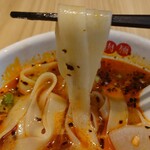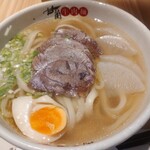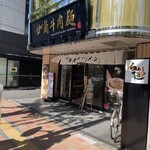
甘蘭牛肉麺 東京神保町店
Kanrangyuunikumen
3.16
Jinbocho, Suidobashi
「Ramen」
--
--
Opening hours: 11:00-15:0017:00-23:00 Open Sundays
Rest time: nashi (Pyrus pyrifolia, esp. var. culta)
東京都千代田区神田神保町1‐42‐4
Photos
(20)




















Details
Reservation Info
No Reservations
Payment Method
Credit cards accepted
(VISA, Master, JCB)
Electronic money is not accepted
QR code payment accepted
(PayPay, Rakuten Pay)
Number of Seats
26 seats
(counter seats, table seats)
Private Dining Rooms
None
Smoking and Non-Smoking
No smoking at the table
Parking
None
Facilities
Large seating area, counter seating available, sofa seating available
Comments
(17)
たか6
3.50
When I went to a Sri Lankan restaurant nearby, I heard that it would be private, so I decided to go here on a whim! The beef bone soup sounded tempting, right? As soon as you enter, you are prompted to input your choice of noodles, whether you want coriander, and so on at the ticket machine. I see, the menu consists of just one item, very Chinese-like. There is a restaurant called "Makoroku Beef Noodle Kanda Branch" nearby, so it seems similar. Now, the soup is light and clear, not very rich, but still quite delicious. The noodles are firm and not bad, but they don't seem to be well coated in the soup. If you add chili oil (tastes like doubanjiang), it tastes familiar and comforting! Maybe it would have been better not to add it. And the beef char siu (?). It is very tenderly cooked, but you can see an unprecedented amount of beef fat (?) injected into the meat. They emphasize that it is domestic (Japanese) beef, but once they've gone to such lengths, it doesn't really matter anymore!

チャオボーノ
3.00
Compared to a certain famous restaurant, the ingredients are larger! The meat is thick and tender, the daikon radish is thick and flavorful like oden, and there are plenty of eggs and cilantro (which can be removed). You buy your meal quickly at the ticket machine. You can customize the noodles, but today I chose triangular noodles, which have a texture similar to knife-cut noodles. The soup is a clear beef broth, with a good collaboration of spiciness from the chili oil. You can also change the flavor with black vinegar. The style is to come alone, eat quickly, and leave. I was able to eat without waiting in the new, spacious restaurant.



iwanaiwana
3.60
I have been hearing a lot about "mixed noodles" recently, but I had never tried them before. I happened to come across an article mentioning a restaurant in Jinbocho that serves mixed noodles, so I decided to visit. I chose the cold, flat noodles option and when it arrived, I saw that the noodles were served separately from the vegetables (with coriander), char siu pork, and sauce on a plate. I mixed everything together and the strong flat noodles paired well with the garlic and spicy sauce. The char siu pork and vegetables added a nice touch. Despite the chewy texture and generous portion, it was surprisingly easy to eat. This dish is perfect for summer in Japan, which is becoming more Southeast Asian in style. I highly recommend this Asian-inspired noodle dish. It was quite enjoyable.


無芸小食
3.40
Along the Shirayama Street, right next to HACHI Tokyo, Kamran Beef Noodle opened in June 2023. This location used to be the Honest Butcher's Dining before, right? When it comes to Lanzhou noodles, the trend started in Japan around 2017 with places like Maboku Beef Noodles in Jimbocho and Ranjou Ramen Shop Kaen-zan in Ikebukuro. Six years have passed since then, and the trend is still going strong. Some even speculated that the initial popularity in Japan was due to the subliminal effect of China's "Belt and Road Initiative." The Belt and Road Initiative consists of the Silk Road Economic Belt (the Belt) and the 21st-century Maritime Silk Road (the Road), aiming to promote infrastructure development, trade, and financial cooperation. Among the Chinese community in Japan, there was a belief that serving authentic Chinese dishes like Lanzhou noodles or lamb would be profitable, leading to a transformation of traditional Chinese restaurants. Kamran Co., Ltd., the company operating this restaurant, opened the Kamran Beef Noodle Nihonbashi Main Store in Osaka in July 2020 during the pandemic and has since expanded to 13 stores in Kansai and Kanto regions. On the day of my visit at 8:30 PM, there were two touch panel ticket machines. There are four tabs: "Recommended," "Chinese Side Dishes," "Special Noodles," and "Drinks." Under "Special Noodles," you can find options like Kamran Mixed Noodles and Sliced Beef Ramen. As a first-timer, I chose the Kamran Beef Noodle (890 yen) from the "Recommended" section. You can select the amount of noodles, type of noodles, cilantro, chili oil, and number of beef slices. I chose large serving, triangular noodles, normal cilantro, normal chili oil, and 4 beef slices. I also added an Asahi bottled beer (500 yen) and Kamran Fried Dumplings (190 yen). While sipping on my beer, the Kamran Beef Noodle arrived. In Lanzhou noodles, there is a saying, "one clear, two white, three red, four green, five yellow." The clear broth (one clear) is a light beef bone soup. Six pieces of sliced daikon (two white) cover the right side of the soup. Red chili oil (three red) floats on top of the bowl. Cilantro and chopped green onions (four green) cover the left side of the soup. In the center, there are four blackish half-moon-shaped beef slices. The triangular noodles (five yellow) resemble buckwheat grains and have a sharp texture. The unique chewiness of the noodles was excellent! In the second half, I added vinegar for a change in flavor. The crunchy texture of the finely chopped vegetables like garlic sprouts blended well with the soup, and I couldn't help but finish every drop. As I indulged in the meal, I couldn't help but wonder if the Silk Road's spirit was blowing through me. Perhaps the "Belt and Road Initiative" has infiltrated the deep psyche of Japanese men, creating a sense of closeness. The power of the Belt and Road Initiative is truly remarkable!




Racco903
3.40
This is a new branch of Lanzhou Ramen that opened in June 2023 in Jinbocho, the second one in the area. The entrance is decorated in black and gold, giving off a luxurious vibe. The interior has a clean and cozy cafe-like atmosphere with wooden decorations. I ordered the Sweet Beef Noodle for 890 yen and the Sweet Beef Dumplings for 190 yen. The noodle options include thin, medium, triangle, and flat noodles, and I chose the chewy triangle noodles with normal spiciness and no cilantro. The beef noodle soup here is quite light in flavor, with a clear broth that sparkles with orange-colored chili oil. The noodles had a nice chewy texture, but the light soup might be a bit lacking. Adding black vinegar halfway through enhanced the depth of flavor. The beef chashu was good, and the toppings included simmered daikon and cilantro. I felt like adding more cilantro and chili oil next time for a richer taste. The mini-sized dumplings were flavorful and easy to eat. Overall, it was a guilt-free and satisfying dinner in a stylish setting with convenient PayPay payment options. Despite the initial hype dying down, I hope this unique noodle shop thrives, and I plan to revisit in the future.




nobor718
3.30
I visited this place for lunch on Wednesday. I arrived at 11:40 and there was only one other customer in the restaurant. I purchased a ticket for the A set meal for 1100 yen from the touch panel ticket machine near the entrance, and sat at a table nearby. The food was served in about 5 minutes. The meal included beef noodles, beef slices similar to char siu, and rice. The beef noodles were made with medium straight noodles and were quite delicious. I found that dipping the beef in garlic soy sauce and eating it with the rice was more satisfying. Overall, I think getting the set meal was a good choice.




TA・KA
3.10
On this day, before I knew it, it was already 2:30 PM, and I found myself looking for a restaurant that was still open. I decided to head towards the Jimbocho area, and that's when I saw the sign for Amaranth Beef Noodle again. I had tried their mixed noodles at the Iidabashi branch the other day and found it surprisingly good, so I thought of giving it a try here today. Just like the Iidabashi branch, they had two ticket machines side by side for ordering. I was considering getting the beef noodle, but then I scrolled through the menu and saw a special menu item labeled as a gift from the gods. Upon closer inspection, it seemed like the beef noodle without the meat. It was 100 yen cheaper without the meat, so even though the cost performance wasn't great, I thought if I was going to end up disappointed again, at least without the meat, it would be within a coin and I could accept it. Or rather, what made it a gift from the gods? So, I decided to go for the Manara Ramen Regular without meat (490 yen), with flat noodles, no cilantro, and normal level of spicy oil. I made my payment and handed the food ticket to the waiting staff. There were 4 groups of customers and 7 people inside, and I was directed to an empty table where a glass of water was already placed. Unlike the Iidabashi branch, all the staff here seemed to be male. The food arrived in just over 9 minutes, which was quite fast considering the 4 other customers waiting for their orders. They also handed me a paper apron when serving the bowl. The soup seemed to have a strong presence of spicy oil. Trying to recall my faint memories of the beef noodle I had before, I wondered if it had such a strong spicy oil flavor. Maybe that was why I didn't like it, as the subtle flavors of the soup and the spices like star anise stood out. As I sipped the soup, I found it to be different this time. I could actually drink it normally. Maybe a bit spicier would have been better. The flat noodles were nice and chewy, just like the mixed noodles I had before. Looking back, I think the beef noodles I had in the past were thin or triangular noodles. Maybe flat noodles suit it better. The hot daikon radish that I occasionally bit into was well-infused with the soup, and it complemented the flavors nicely. The egg seemed like a regular boiled egg, not particularly seasoned. I opted for the regular portion this time, so it felt a bit lacking, but it was the first time I found the beef noodles (without the beef) to be delicious. Maybe it was because it was a different branch, but my impression of it changed a bit. I finished the noodles while sipping on the slightly spicy soup, cooled down with the water, and concluded my lunch. I don't think I'll come here frequently, but maybe my previous aversion has slightly changed.




リンダ リンダ
3.10
My first experience trying beef bone ramen. I had to purchase a ticket from a vending machine first, but I struggled with the Korean characters on the screen. Eventually, I managed to buy the ticket and sat down. The ramen arrived in about 5 minutes. It came with half a boiled egg, 8 slices of beef chashu, 6 slices of daikon with ginkgo nuts, and I chose triangular noodles. They were making the noodles in the store. I managed to eat it with black vinegar, but to be honest, it tasted more like udon.



トントンマン
3.50
A Chinese restaurant that faithfully reproduces the authentic taste of China is gaining popularity. These types of restaurants used to mainly target Chinese people staying in Japan, providing them with the taste of their homeland. However, due to the restrictions on overseas travel caused by the COVID-19 pandemic, there has been an increase in Japanese customers who want to experience the exotic flavors of foreign cuisine while in Japan. In contrast to the "local Chinese cuisine" that has been developed with the taste preferences of Japanese people in mind, these authentic Chinese restaurants are now referred to as "real Chinese cuisine" and have become quite popular.
One such restaurant that I decided to visit is located in Jinbocho, which is currently my main lunch spot. The restaurant, named Kanran Gyuniku Men, is operated by Kanran Co., Ltd., a company established in Osaka in August 2019 by Chinese entrepreneurs. The company, which is a holding company with main businesses in corporate consulting, real estate transactions, and insurance agency, seems to have ventured into the food industry with a focus on beef noodles to capitalize on the beef noodle trend. The first store, Kanran Gyuniku Men Nihonbashi Honten, opened in July 2020, just three months after the nationwide emergency declaration was issued in April 2020.
The timing of their expansion coincided with the COVID-19 pandemic, making it a challenging period for their business. Despite the temporary lifting of the emergency declaration at the end of May, the repercussions of the emergency situation continued, making it difficult for the new store to thrive. The restaurant expanded to Tokyo in 2022, opening the Kanran Gyuniku Men Shibuya Honten near the former Tokyu department store in August. With a high potential for franchise development, they quickly opened more stores in the Tokyo area, including Shinjuku Nishiguchi, Tokyo Jujo Ginza, Tokyo Iidabashi, and Saitama Kawaguchi, before opening the store I visited in June.
The restaurant is located along Hakusan Street, about 200 meters from the Jinbocho intersection towards Suidobashi on the right side. Arriving a bit late for lunch, I found that the lunch menu had already sold out. Therefore, I ordered the regular portion of Kanran Gyuniku Men for 890 yen, choosing flat noodles and specifying the amount of coriander and chili oil. The restaurant interior features a touch panel ticket machine at the entrance, but since lunch was no longer available, I proceeded to order directly from the counter.




すすっち
3.00
I had seen a few beef noodle shops and was curious, so I decided to try one. I ordered the signature Sweet Orchid Beef Noodles with medium noodles. It seems that you can get a free upsize, but since it was my first time, I stuck with the regular size. You can also choose whether to add chili oil or cilantro, but being a first-timer, I opted out. The clear soup was delicious. It's a bit different from regular ramen, but still tasty in its own way. I imagine adding chili oil or cilantro would change the flavor too. I definitely want to come back and try it again.

C.R.O
3.20
The shop that opened on 6/8, let's just try going in. There were 2 touch panel ticket machines, and since there were no other customers, it was fine, but it can be a bit stressful for some people. The recommended shop name is the same as the specialty dish: "Amber Orchid Beef Noodle." The large size is free, with medium thick noodles, no cilantro, and the chili oil is moderate. It was served in 8 minutes. It looks a bit spicy, but it's not that spicy, so even those who don't like spicy food might enjoy it. The soup is quite light with medium thick noodles, which are unusually long! Trying to slurp them without cutting them made me feel like I was hyperventilating. The chewy noodles in the large size portion left me very satisfied. The custom set comes with black vinegar, which I tried adding and found it delicious! I've only used vinegar for dumplings before, but this ramen is complete with the generous addition of black vinegar! Next time, I might try thin noodles with double the chili oil!




CHITAN
3.30
I had been curious about this restaurant for a while as it seemed to be preparing to open for quite some time. Finally, on June 8th, it opened its doors. This restaurant, "Ganlan Beef Noodle," is the second of its kind in the area, with over 3,000 similar establishments in the original city of Lanzhou, China. I visited on the first day it opened and tried their signature dish, the Ganlan Beef Noodle for 590 yen. There was a promotion until June 10th, after which the price would go back to 890 yen. The place was crowded, possibly due to the promotion. I accidentally ordered without customizing my noodle size, but they kindly allowed me to change it later. The noodles were triangular in shape, similar to another famous noodle shop. The spice level was adjustable, with options for normal, medium, and extra spicy for an additional cost. Overall, the noodles were delicious and easy to eat, and the menu also offered a variety of side dishes. I look forward to seeing how this restaurant will fare in the competitive noodle and curry scene of Kanda-Jimbocho.




8810otayah
3.50
Homemade hand-pulled noodles


just3154
3.00

となりの獣医さん
3.50

おうしゃ
3.50
I went to this restaurant that opened on 6/8 and is offering a special discount until the 10th. I was impressed by the gentle yet flavorful taste when I first tried it at the Shinjuku branch, and the taste here was just as good. At the Shinjuku branch, there was a guy stretching the noodles in the kitchen, but I didn't see that here...? I tried the thin noodles this time, but they were a bit too soft for my liking, so maybe the recommended medium-thick noodles would be better after all.


f30c2c
3.50
It was delicious!
Email Login